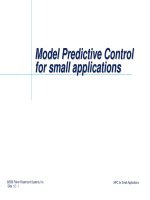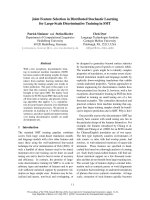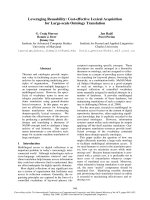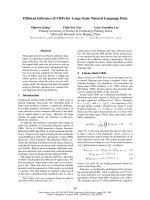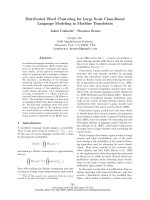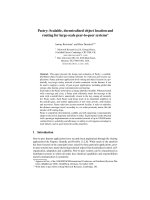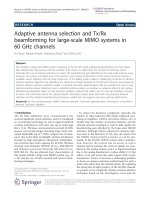Coordinating multiple model predictive controllers for large scale systems
Bạn đang xem bản rút gọn của tài liệu. Xem và tải ngay bản đầy đủ của tài liệu tại đây (1.82 MB, 172 trang )
COORDINATING MULTIPLE MODEL PREDICTIVE
CONTROLLERS FOR LARGE-SCALE SYSTEMS
ABHAY ANAND
NATIONAL UNIVERSITY OF SINGAPORE
2014
ii
COORDINATING MULTIPLE MODEL PREDICTIVE
CONTROLLERS FOR LARGE-SCALE SYSTEMS
ABHAY ANAND
B.E. (Hons), Birla Institute of Technology and Science, Pilani, India
A THESIS SUBMITTED
FOR THE DEGREE OF DOCTOR OF PHILOSOPHY
DEPARTMENT OF CHEMICAL & BIOMOLECULAR ENGINEERING
NATIONAL UNIVERSITY OF SINGAPORE
2014
iv
vi
ACKNOWLEDGMENTS
I would like to express my sincere thanks to my supervisor, Prof. Lakshminarayanan Samavedham for being such a wonderful mentor. I am greatly indebted
to him for his constant guidance, support and encouragement throughout the course
of my graduate studies. I have learned a lot from him and his lateral perspectives
on education and research have greatly influenced me both academically as well as
professionally.
I also owe Prof. Sundaramoorthy a big thank you for getting me started on
my research and providing the initial impetus and motivation to pursue this very
interesting field of research. I thank Dr. Kiran for being my mentor in the lab,
guiding me through the various phases of my PhD. I would also like to thank the
Informatics and Process Control Unit (IPCU) team Raghu, Sundar, Kiran, Logu,
Prem, Manoj, Vaibhav, Naviyn, Pavan, Krishna, Kalyan and Karthik for helping me
shape this work with their valuable suggestions and constructive criticism. It has
been a pleasure sharing the lab and working with the IPCU team. A special thanks
to Dr. Raghu for introducing me to the Singapore Delft Water Alliance (SDWA).
I would like to thank Prof. Vladan Babovic and Mark Womersley at SDWA, for
having great faith in me and funding my research. During my time at SDWA, I have
had the privilege to work with some of the most talented researchers. I would like
to thank Dr. Abhijit Badwe, Dr. Stefano Galelli and Dr. S K Ooi for their guidance and stimulating discussionSs on various engineering problems. SDWA being an
interdisciplinary research organization has helped me understand the need for communication and cooperation in solving real world problems. Working in a diverse
environment has been intellectually stimulating and has helped me keep things in
perspective. I would like to thank Albert and Ali, my fellow PhD students at SDWA
for making my stay at graduate school memorable. I would also like to thank my
colleagues at SDWA – Serene, Alam, Pavlo, Petra, Jingjie, Javier, Gerard, Joost
and many others for providing an environment conducive to learning. Also a special
thanks to Anji, Satya and Jeffro for making life in Singapore all the more enjoyable.
vii
I would like to thank Prof. Rangaiah and Prof. Chiu Min Sen for serving on
my qualifying examination committee and providing me with invaluable feedback
on my research direction and progress.
I would like to thank the very efficient ChBE and SDWA admin team for helping
me process innumerable forms through the course of my studies. Thank you Ivy,
Sally, Saedah, Doris and Tan Hui Ting.
Lastly, I would like to thank my parents and my sister Aarti, for their love and
constant encouragement.
viii
TABLE OF CONTENTS
Page
Summary . . . . . . . . . . . . . . . . . . . . . . . . . . . . . . . . . . .
xiii
List of Tables . . . . . . . . . . . . . . . . . . . . . . . . . . . . . . . . .
xv
List of Figures . . . . . . . . . . . . . . . . . . . . . . . . . . . . . . . .
xvii
Abbreviations . . . . . . . . . . . . . . . . . . . . . . . . . . . . . . . . .
xix
Nomenclature . . . . . . . . . . . . . . . . . . . . . . . . . . . . . . . . .
xxi
1 Introduction . . . . . . . . . . . . . . . . . . . . . . . . . . . . . . . .
1
1.1
Background and Motivation . . . . . . . . . . . . . . . . . . . . .
1
1.2
Objectives . . . . . . . . . . . . . . . . . . . . . . . . . . . . . . .
5
1.3
Thesis Organization . . . . . . . . . . . . . . . . . . . . . . . . . .
6
2 Literature review . . . . . . . . . . . . . . . . . . . . . . . . . . . . .
9
2.1
Control Architectures for Large-scale Systems . . . . . . . . . . .
9
2.2
Model Predictive Control and its Application . . . . . . . . . . . .
11
2.3
Coordinating Multiple Model Predictive Controllers . . . . . . . .
15
2.4
Minimum Information Exchange Based Coordinated Model Predictive Control . . . . . . . . . . . . . . . . . . . . . . . . . . . . . .
19
2.5
Coordinating Multiple Model Predictive Controllers for Multi-Reservoir
Management . . . . . . . . . . . . . . . . . . . . . . . . . . . . . .
22
2.6
Summary . . . . . . . . . . . . . . . . . . . . . . . . . . . . . . .
24
3 Coordinating Multiple Model Predictive Controllers . . . . . .
25
3.1
Introduction . . . . . . . . . . . . . . . . . . . . . . . . . . . . . .
25
3.2
Coordinated Model Predictive Control . . . . . . . . . . . . . . .
27
3.2.1
Communication Based Coordination . . . . . . . . . . . .
38
3.2.2
Cooperation Based Coordination . . . . . . . . . . . . . .
40
3.2.3
Price Driven Coordination . . . . . . . . . . . . . . . . . .
42
Case Studies . . . . . . . . . . . . . . . . . . . . . . . . . . . . . .
50
3.3.1
Shell Benchmark Problem . . . . . . . . . . . . . . . . . .
51
3.3.2
Quadruple Tank System . . . . . . . . . . . . . . . . . . .
62
3.3
ix
Page
3.4
Conclusions . . . . . . . . . . . . . . . . . . . . . . . . . . . . . .
69
4 Minimum Information Exchange Based C-MPC Architectures
73
4.1
Introduction . . . . . . . . . . . . . . . . . . . . . . . . . . . . . .
73
4.2
Minimum Information Exchange Based Coordination . . . . . . .
74
4.3
Case Studies . . . . . . . . . . . . . . . . . . . . . . . . . . . . . .
83
4.3.1
Shell Benchmark Problem . . . . . . . . . . . . . . . . . .
83
4.3.2
Distillation Column Control . . . . . . . . . . . . . . . . .
86
4.3.3
Complex Sidestream Column/Stripper Distillation Control
90
4.4
Communication Disruption . . . . . . . . . . . . . . . . . . . . . .
94
4.5
Conclusions . . . . . . . . . . . . . . . . . . . . . . . . . . . . . .
99
5 Application of Coordinated Model Predictive Control for MultiReservoir Management Systems . . . . . . . . . . . . . . . . . . .
103
5.1
Introduction . . . . . . . . . . . . . . . . . . . . . . . . . . . . . .
103
5.2
Multi-Objective Two Reservoir System . . . . . . . . . . . . . . .
104
5.2.1
Comparison of performance with perfect and non-perfect inflow forecast . . . . . . . . . . . . . . . . . . . . . . . . . .
111
Comparison of costs at individual reservoirs . . . . . . . .
112
Alqueva Multi-Reservoir System . . . . . . . . . . . . . . . . . . .
114
5.3.1
Controller Set-up . . . . . . . . . . . . . . . . . . . . . . .
117
5.3.2
Results and Discussion . . . . . . . . . . . . . . . . . . . .
120
Conclusions . . . . . . . . . . . . . . . . . . . . . . . . . . . . . .
122
6 Conclusions and Recommendations for Future Research Work
125
5.2.2
5.3
5.4
6.1
Conclusions . . . . . . . . . . . . . . . . . . . . . . . . . . . . . .
125
6.2
Contributions of this thesis . . . . . . . . . . . . . . . . . . . . . .
131
6.3
Recommendations for Future Work . . . . . . . . . . . . . . . . .
132
6.3.1
Handling Coupled Input Constraints . . . . . . . . . . . .
133
6.3.2
Data-based Interaction Analysis and Adaptive Minimum Information Exchange Schemes . . . . . . . . . . . . . . . .
133
Coordinating Model Predictive Controllers for Multi-rate Systems . . . . . . . . . . . . . . . . . . . . . . . . . . . . . .
134
6.3.3
Appendix A - Wegstein’s Method . . . . . . . . . . . . . . . . . . . .
137
Bibliography . . . . . . . . . . . . . . . . . . . . . . . . . . . . . . . . .
138
x
Publications & Presentations . . . . . . . . . . . . . . . . . . . . . . .
147
xi
xii
SUMMARY
Many large-scale systems are formed by the interconnection of several subsystems, whose different spatial and temporal characteristics make them significantly
heterogeneous. The optimal management of such systems must generally deal not
only with issues related to large dimensionality, but also with the presence of several interactions between the subsystems, which have a significant influence on the
local control decisions and the overall system optimality. For such large-scale systems, model predictive control (MPC) is an attractive control strategy that can
be implemented in centralized or decentralized configurations. It has been shown
that, to achieve a flexible and reliable control structure with optimum overall system performance, individual decentralized controllers have to be coordinated and
driven towards the performance of a centralized controller. In this work, based
on three coordination strategies that have been reported in the literature, viz.,
(1) communication-based coordination, (2) cooperation-based coordination, and (3)
price driven coordination, we have reformulated and evaluated different methods
for coordinating multiple linear MPCs. These strategies have been evaluated on
benchmark chemical engineering systems (via simulations), on the basis of their robustness, stability, and performance in comparison to that of a centralized MPC
implementation. The ability to deal with a variety of model uncertainties and varying intensities of interactions are important aspects that have been investigated.
Based on the analysis of the different MPC coordination strategies, cooperationbased coordination has been selected as a robust and efficient control strategy and
methods to improves its performance have been analyzed.
The number of interactions between subsystems in large-scale systems increases
exponentially with the number of subsystems, making coordinated MPC (C-MPC)
architecture effective but not computationally efficient. Hence, it is desirable to reduce the computational load of the coordination architecture without significantly
compromising the overall performance. In order to achieve this, a genetic algorithm
(GA) based optimizer is utilized to identify the trade-off between various optimal
interaction topologies and the associated performance deterioration. To enhance the
efficiency of the GA optimizer, the relative normalized gain array (RNGA) is used
xiii
to identify the most critical interactions and this knowledge is incorporated into
the GA optimizer, significantly reducing the search space leading to faster convergence. A common problem involving large-scale control networks is the disruption
of communication. Delay or losses in the information exchange could lead to local
control decisions that destabilize the overall system. In order to tackle the problem of communication disruptions, the utility of the GA optimizer as a useful and
effective tool to handle communication disruptions has also been highlighted. The
catalog of pareto optimal solutions generated by the GA optimizer can be utilized
as an easy-to-use look up table to identify alternate communication protocols in the
presence of disruptions.
Finally, multi-reservoir management has been identified as a large-scale system
where the application of coordinated control strategies could have substantial benefits. The application of the C-MPC architecture for real world water management
systems is evaluated through the analysis of a two reservoir test case and a high
fidelity model of the Alqueva multi-reservoir system in Portugal.
xiv
LIST OF TABLES
Table
Page
3.1
Performance Indices for Shell benchmark case study . . . . . . . . . .
54
3.2
Performance Indices for shell benchmark case study (MIMO Configuration) . . . . . . . . . . . . . . . . . . . . . . . . . . . . . . . . . . . .
59
Performance Indices in the presence of model-plant mismatch (Gain Mismatch) . . . . . . . . . . . . . . . . . . . . . . . . . . . . . . . . . . .
60
Performance Indices in the presence of model-plant mismatch (Dead
Time Mismatch) . . . . . . . . . . . . . . . . . . . . . . . . . . . . .
60
Performance Indices in the presence of model-plant mismatch (Time Constant Mismatch) . . . . . . . . . . . . . . . . . . . . . . . . . . . . .
61
Performance Indices for the quadruple tank case study (Minimum Phase
Configuration) . . . . . . . . . . . . . . . . . . . . . . . . . . . . . .
65
Performance Indices for the quadruple tank case study (Non-Minimum
Phase Configuration) . . . . . . . . . . . . . . . . . . . . . . . . . . .
65
Performance Indices for the quadruple tank case study (Minimum Phase
Configuration) in the presence of Model-Plant Mismatch . . . . . . .
67
Performance Indices for the quadruple tank case study (Minimum Phase
Configuration) in the presence of Model-Plant Mismatch . . . . . . .
67
3.10 Performance Indices for the quadruple tank case study (Minimum Phase
Configuration) in the presence of Model-Plant Mismatch . . . . . . .
68
4.1
NSGA Parameters . . . . . . . . . . . . . . . . . . . . . . . . . . . .
79
4.2
Performance comparison of the various optimal control topologies for the
shell benchmark problem . . . . . . . . . . . . . . . . . . . . . . . . .
86
Performance comparison of the various optimal control topologies for the
distillation column case study . . . . . . . . . . . . . . . . . . . . . .
90
Performance comparison of the various optimal control topologies for the
complex sidestream stripper case study . . . . . . . . . . . . . . . . .
96
Information exchange scheme for 6 interactions topology of the complex
sidestream stripper case study . . . . . . . . . . . . . . . . . . . . . .
98
Comparison of alternate communication topologies in the presence of
communication disruption . . . . . . . . . . . . . . . . . . . . . . . .
99
3.3
3.4
3.5
3.6
3.7
3.8
3.9
4.3
4.4
4.5
4.6
5.1
Performance Indices for the two reservoir system with a perfect inflow
114
xv
Table
Page
5.2
Performance Indices for the two reservoir system with a perfect inflow
114
5.3
RMSE (with respect to the centralized MPC configuration) for the decentralized and coordination-based MPC (with different number of iterations). . . . . . . . . . . . . . . . . . . . . . . . . . . . . . . . . . .
121
xvi
LIST OF FIGURES
Figure
Page
2.1
Hierarchical Control Structure. . . . . . . . . . . . . . . . . . . .
12
2.2
Model Predictive Control . . . . . . . . . . . . . . . . . . . . . . .
15
3.1
Schematic of Communication and Cooperation Based MPC Coordination. . . . . . . . . . . . . . . . . . . . . . . . . . . . . . . . . .
42
3.2
Schematic of Price Driven MPC Coordination. . . . . . . . . . . .
43
3.3
Shell Heavy Oil Fractionator (Adapted from Maciejowski (1999)) .
52
3.4
Comparison of the shell oil system output variables’ response under
different control configurations. . . . . . . . . . . . . . . . . . . .
55
Convergence of Cooperation Based Coordinated MPC to Centralized
Performance. . . . . . . . . . . . . . . . . . . . . . . . . . . . . .
56
3.6
Quadruple Tank System . . . . . . . . . . . . . . . . . . . . . . .
63
3.7
Comparison of the four tank system output variables’ response under
different control configurations. . . . . . . . . . . . . . . . . . . .
66
4.1
A schema of the implemented NSGA method . . . . . . . . . . . .
78
4.2
Relation between number of subsystems and the corresponding number of interactions . . . . . . . . . . . . . . . . . . . . . . . . . . .
80
Relation between the number of subsystems and the possible number
of communication topologies . . . . . . . . . . . . . . . . . . . . .
80
Performance comparison of the shell benchmark problem for various
optimal interaction topologies (im31 = 1) . . . . . . . . . . . . . .
85
Distillation column control schematic (Adapted from Ogunnaike et al.
(1983)) . . . . . . . . . . . . . . . . . . . . . . . . . . . . . . . . .
87
Performance comparison of the distillation column case study for various optimal interaction topologies . . . . . . . . . . . . . . . . .
89
Complex Sidestream Column/Stripper Distillation Control Schematic
(Adapted from Alatiqi & Luyben (1985)) . . . . . . . . . . . . . .
91
Performance comparison of the complex sidestream stripper case study
for various optimal interaction topologies (im41 = 1) . . . . . . . .
93
Performance comparison of the complex sidestream stripper case study
for various optimal interaction topologies (im41 = im32 = im23 = 1)
95
3.5
4.3
4.4
4.5
4.6
4.7
4.8
4.9
xvii
Figure
Page
4.10 Alternate communication topologies in the presence of communication disruption . . . . . . . . . . . . . . . . . . . . . . . . . . . .
99
5.1
Performance comparison (mean and variance) of total, upstream and
downstream costs (upper, middle and lower panel) of centralized
(blue), coordinated-50 iterations (green), coordinated-5 iterations (yellow) and decentralized (red) MPC (with perfect and non-perfect inflow forecast). . . . . . . . . . . . . . . . . . . . . . . . . . . . . .
112
5.2
Alqueva multi-reservoir: location and schema of the system . . . .
116
5.3
Comparison of pump discharges of Centralized MPC (Green) and 5
Iterations of Coordinated MPC (Blue) . . . . . . . . . . . . . . .
122
xviii
ABBREVIATIONS
C-MPC
Coordinated Model Predictive Control
DBRGA
Dynamic Block Relative Gain Array
ERGA
Effective Relative Gain Array
GA
Genetic Algorithm
HIIA
Hankel Interaction Index Array
II
Interaction Index
IM
Interaction Matrix
MIE
Minimum Information Exchange
MIMO
Multi-Input Multi-Output
MPC
Model Predictive Control
MPM
Model-Plant Mismatch
MOO
Multi-Objective Optimization
NSGA
Non-dominated Sorting Genetic Algorithm
PAES
Pareto-Achieved Evolution Strategy
PID
Proportional-Integral-Derivative
PRGA
Performance Relative Gain Array
QP
Quadratic Programming
RGA
Relative Gain Array
RMSE
Root Mean Square Error
RNGA
Relative Normalized Gain Array
RTO
Real-Time Optimization
SISO
Single-Input Single-Output
SPEA
Strength Pareto Evolutionary Algorithm
SSE
Sum of Squared Errors
xix
xx
NOMENCLATURE
Chapter 3
M
Number of Subsystems
y˜
Output variable vector
u˜
d˜
Manipulated variable vector
˜p
G
˜d
G
Process transfer function matrix
˜ ij (z)
G
Transfer function model between the input to i-th subsys-
Measured disturbance vector
Disturbance transfer function matrix
tem and the output of the j-th subsystem
Np
Number of step response coefficients for process transfer
function
Nd
Number of step response coefficients for disturbance transfer
function
P
Prediction horizon
C
Control horizon
N
Model horizon
YiM
Current measurement of controlled variables
∆u
Change in manipulated variable
hi (t)
Effect of future inputs of other subsystems on the i-th subsystem output
Fij
Effect of past inputs
Fdi
Effect of measured disturbances
Fi
Cost function
Ji
Cost function of each subsystem
RSi
Vector of individual subsystem set point
qi and ri
Tunable weights
wi
Weight on individual objective functions
ei
Auxiliary variable
vi
Auxiliary vector
λ
Lagrange multiplier
g
k
Gradient at k th iteration
xxi
γ
Valve position
Chapter 4
imij
Interaction model between the input to i-th subsystem and
the output of the j-th subsystem
KN
Normalized gain matrix
kN,ij
˜ ij
Normalized gain of transfer function G
τar,ij
˜ ij
Average residence time of transfer function G
Φ
Relative normalized gain array
Chapter 5
st
Storage [m3 ]
ut
Release decision [m3 /s]
∆
Integration time-step
at
Inflow from uncontrolled catchment [m3 /s]
µ
Mean
Cv
Coefficient of variation
ρf low
Coefficient of correlation
δ
Standard normal random number
qt
Total inflow [m3 /s]
Pt
¯i
Energy production [kW h/day]
ht
Reservoir level [m]
xt
State vector
ut
Control vector
εt
Disturbance vector
τ
Time-step
gτ (.)
Normalized step cost function accounting for the costs as-
Water demand [m3 /s]
sociated to the state transitions
g¯t+h (.)
Penalty function related to the final state
xt+h
Final state
umax
Upper bound on manipulated variable
sp
h
Water level setpoint
hdown , hup
Bounds on water levels
Q
flow rate [m3 /s]
t
Time[s]
x
One-dimensional coordinate [m]
qlat
Unit side flow rate [m2 /s]
xxii
Af
g
Wetted section area [m2 ]
Acceleration due to gravity [m/s2 ]
h
Flow depth [m]
C
Chezy coefficient [m0.5 /s]
R
Hydraulic radius [m]
Wf
Surface width [m]
τwind
Shear stress due to wind [N/m2 ]
ρw
Density of water [kg/m3 ]
ws
Width of the structure
zs
Crest level
dg
Gate setting
xxiii
xxiv
Chapter 1 Introduction
Chapter 1
INTRODUCTION
1.1
Background and Motivation
A particular class of large-scale systems are characterized by the presence of a
network of several interconnected subsystems. The varying dynamics of the individual subsystems and the presence of several interactions between these subsystems
make these large-scale systems significantly heterogeneous with local control decisions having a significant effect on the overall system optimality. Thus, the optimal
management of such systems is a challenging endeavor. Real-time management in
the form of Model Predictive Control (MPC) is one of the most popular techniques
implemented for such systems due to its ability to use real-time data and forecasts to predict future outcomes. MPC has now evolved into a successful control
strategy for the integrated control of large-scale multi-variable processes that are
subject to operational constraints. Two common paradigms for the implementation
of MPC are the centralized and decentralized control implementation. In a centralized MPC implementation, a single monolithic controller is designed and such an
implementation is plant-wide optimum. However the centralized implementation is
computationally intensive, relatively difficult to implement, tune and maintain, and
is characterized by poor fault tolerance (Venkat et al. (2007)). On the other hand,
a decentralized MPC implementation involves the design of multiple independent
1
